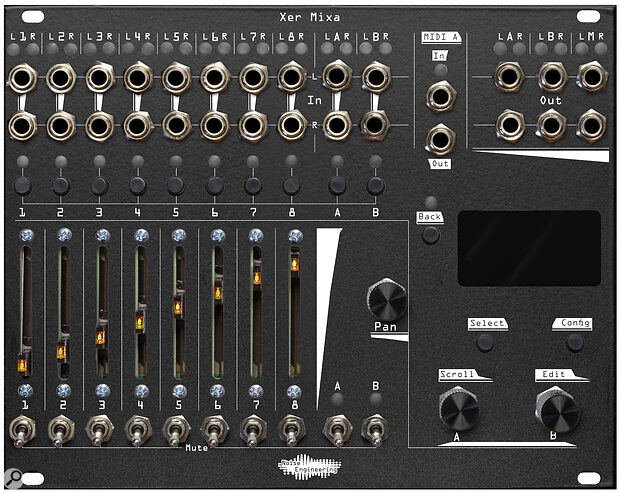The Xer Mixa mixer is something of a step out for Noise Engineering, but it also takes the LA‑based company back to their roots. “The story of Xer Mixer starts way back before you heard of Noise Engineering,” reads the (very good, I should add) Noise Engineering blog. The ‘problem child’ that became Xer Mixa took almost a decade to develop, with around 20 scrapped versions preceding the product that I now have mounted in my case.
‘A step out?’ I hear you ask. Well, believe it or not, the Xer Mixa is not only the biggest Noise Engineering module yet, measuring a rack‑hungry 32HP, it’s also the very first to include a screen. This may come as a surprise, mainly because of Noise Engineering’s stellar track record in the realm of digital — both hardware and software — and the strident design ethos underpinning the multifaceted (and essentially endless) Versio, Legio and Alia platforms. If you’re not familiar with those then I’d highly recommend a visit to Noise Engineering’s website to find out more.
With eight stereo inputs, two stereo returns and three sets of stereo output buses, Xer Mixa is a large‑format, many‑limbed beast. On first impression I couldn’t but feel that considering the Xer Mixa’s size, the mixer section somehow still feels a little cramped. In practice this isn’t so much of a problem as I thought it might be — I never found myself hitting the wrong button or fumbling to pinpoint controls — but I can’t help wondering if a few valuable HP might have been shaved off the Xer Mixa’s real estate with a few layout adjustments, as well as a little more workspace created.
Screen Time
The screen is where the Xer Mixa’s deep‑diving begins. I daresay that if you’re averse to menu‑heavy modules, you might be more than a little daunted by its workflow. Thankfully it’s a very well‑designed workflow at that, so don’t be too put off. The Home screen presents high‑resolution stereo metering (with both peak and RMS levels, usefully) for all three output buses, with the master volume adjusted by the Pan knob. This might have benefited from being labelled as such, since it feels a little counter‑intuitive to adjust the master level with a knob simply labelled ‘Pan’, but nitpick I shan’t.
Hitting one or more channel buttons calls up a display for that channel’s (or selection of channels’) volume, panning and A and B send level. Tap the Config button to then enter the Channel Configuration menu, which presents options for making the send levels pre‑ or post‑fader — which I was jubilant to see — adjust the pan law and also adjust how panning information is sent to the A and B sends. All in all, that’s some serious potential for precision editing, not normally seen on a Eurorack mixer in my experience. It’s not only easy to set up a submix from either of the aux channels, it’s also possible to mute channels from the master output, meaning it’s possible to have three completely separate stereo mix buses going at once. Clever stuff.
Things get more creative with the Xer Mixa’s generous amounts of remote control. MIDI control over volume, muting, pan and aux send level is available and, with the addition of the excellently‑named Expando Expandi, CV control is too. The integration of Expando Expandi into the Xer Mixa’s workflow is brilliantly done, with CV scaling and offset available as well. There is capacity for up to two of the expanders, too, so the scope for creative automation here is extensive.
As I said in my review of Cosmotronic’s Cosmix Pro mixer, Eurorack mixers must draw the line somewhere in their functionality. Noise Engineering have all but torn up that rulebook, presenting a mixer that boasts functionality more commonly seen on those twice its size, and then some. It even has an in‑built analogue levelling amplifier. It’s almost certain to be the only mixer you’ll foreseeably need in your setup — for Eurorack and perhaps beyond — which is handy, since, considering its price, it’s also likely to be the only mixer you can afford for a while. Some aspects of its layout frustrated me from time to time, as well as its propensity for menu‑diving, but all things considered this is one very powerful unit with tremendous staying power, not to mention an impeccably balanced creativity‑to‑functionality ratio. Noise Engineering can breathe a sigh of relief knowing their ‘problem child’ has finally made its way into the world.
£995
$999


